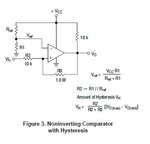Picit
Newbie level 5

I'm using an LM339 as a non-inverting comparator with Hysteresis.
I'm using the circuit provided in the datasheet (see attached image) but my results don't match the maths?

I'm getting close to my desired output using trial and error, but can anyone help me with the calculations:
My values are:
Vcc is 5V
GND = 0V
Rref 14.7k
R1 10k
R2 330k
R3 1M
Vin is a 0-3v analog signal.
Actual Results
VO goes high at 2.63v and goes low at 1.07v using the formulas provided I get very different theoretical results.
Calculated Results
VOHigh : 2.64
VLOw : 1.40
Vref : 2.03
Any help in calculating the actual results would be much appreciated. Thanks.
I'm using the circuit provided in the datasheet (see attached image) but my results don't match the maths?

I'm getting close to my desired output using trial and error, but can anyone help me with the calculations:
My values are:
Vcc is 5V
GND = 0V
Rref 14.7k
R1 10k
R2 330k
R3 1M
Vin is a 0-3v analog signal.
Actual Results
VO goes high at 2.63v and goes low at 1.07v using the formulas provided I get very different theoretical results.
Calculated Results
VOHigh : 2.64
VLOw : 1.40
Vref : 2.03
Any help in calculating the actual results would be much appreciated. Thanks.
Last edited:


